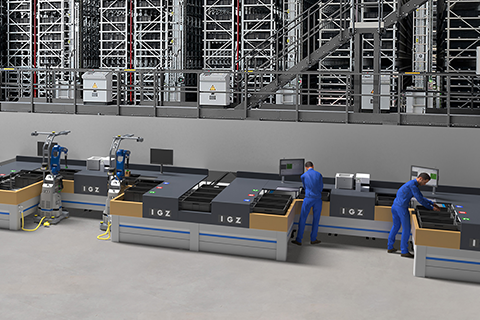Picking explained briefly
Read more

Order picking is usually the biggest efficiency factor or cost driver in intralogistics. Among other things, increasingly small orders requiring a great deal of time and resources contribute to this - caused, for example, by the "legalities" of e-commerce or by supply principles such as just-in-time provision in production and assembly. For all of them, the decree of rapid, on-time and error-free delivery applies. In this respect, the term "supreme discipline" is also apt, especially since order picking offers a maximum of design options. Finding a suitable solution for one's own company here is indeed a challenge. This makes a definition, f.e. a basic understanding of the organization and process of order picking, all the more important. This knowledge also facilitates the selection of individually suitable picking technologies.
Picking refers to the removal and assembly of goods from an assortment of items provided for customer and production orders. This process is either single-stage or multi-stage.
In single-stage picking, each order is handled separately by a picker, who successively processes the individual order items in one operation.
Multi-step picking is required when several pickers are involved in the compilation of an order and the picking order is divided into several sub-steps.
Definition of picking: what services does it include?
The core process of order picking is picking in the form of removal and delivery, i.e. the compilation of a delivery order. This task is carried out conventionally by one person, either purely manually by reaching into the shelves or with the assistance of forklift trucks. The document basis is either a delivery bill (for outbound deliveries) or an internal order slip (e.g. for production supplies).
For some years now, however, robots have also been increasingly used, i.e. picking is completely automated. You can also find more information on the topic of "Robots in order picking" in the blog post of the same name .
If load units of several articles are ordered, several partial steps have to be completed:
However, to focus only on the basic services of order picking is not enough. Upstream and downstream services must also be taken into account. In the upstream phase, these can include replenishment of reserve units, stock planning, and replenishment, in addition to loading the staging areas. Additional services include, for example, the packaging of goods, the marking and labeling of shipping units, and the assembly and securing of loads.
While the additional services are of a more peripheral nature, the preliminary services are elementary for the actual picking process in order to ensure an uninterrupted process and to minimize waiting and idle times.
What has to be considered in the design?
The design of the picking follows defined specifications, which are derived from
and inventory requirements. The assortment requirements, for example, specify the width and nature of the goods assortment. This in turn has a direct impact on the type of supply and the structure of the picking units.
In the case of static staging, for example using pallets and containers, but also of individual parts without load carriers, the number of articles determines the quantitative characteristics of staging areas and space. This must also be taken into account in the system design, as must the throughput requirements that can be derived from the range of goods, the order volume and the order structure. A distinction must be made here as to whether external shipping orders or internal orders are to be processed. The latter can be supply orders for assembly, replenishment orders or even collective orders for a first picking stage.
Another important determinant is the stock to be held in the vicinity of the picking area. These should be dimensioned in such a way that they do not block the picking area or obstruct the process, but at the same time ensure rapid picking with short distances and no waiting times in the case of cost-optimized replenishment.
Picking methods: Single-order vs. multi-order picking - what's the difference?
Variables such as assortment, inventories, throughput and order structure are crucial for the selection/definition of the individually suitable picking method.
Regardless of which method you favor for your company, it is important to clarify whether single-stage picking meets your (or your customers') needs or whether multi-stage picking can do this better (also considered from an efficiency perspective).
In a next step, these cumulated articles must be finally assigned to the order in the corresponding quantity. This is usually done using sorting systems . At this point, it becomes clear that multi-step picking requires technical support on a large scale. On the other hand, however, it is extremely effective and saves the personnel tedious searching and sometimes kilometer-long walking distances, which can be tiring.
However, this presupposes that several target totes (or target cartons), for whose orders the articles are intended, are available. Thus, the picker only has to take the required number of items from the source and place them in the prepared destinations. Both "classic" on-screen dialogs and techniques such as pick-by-light and pick-by-motion are available to provide professional support for this process.
This knowledge facilitates the selection of individually suitable picking technologies, which we discuss in more detail in the article "Picking systems in comparison".
Planning and definition picking - our tip
Order picking is a sub-process of intralogistics with considerable influence on the performance and efficiency of logistics operations. Accordingly, when planning a new warehouse, this area should be designed first and then the other functional zones.
The following steps are recommended for selection and dimensioning :
Have more questions after this blog post on picking definition? We will be happy to help you with dimensioning - whether static or dynamic - taking into account your business strategy. Our Expert:in will be happy to support you in calculating investments and operating costs, putting them in relation to efficiency gains and ensuring that picking keeps costs within a moderate, calculable range.